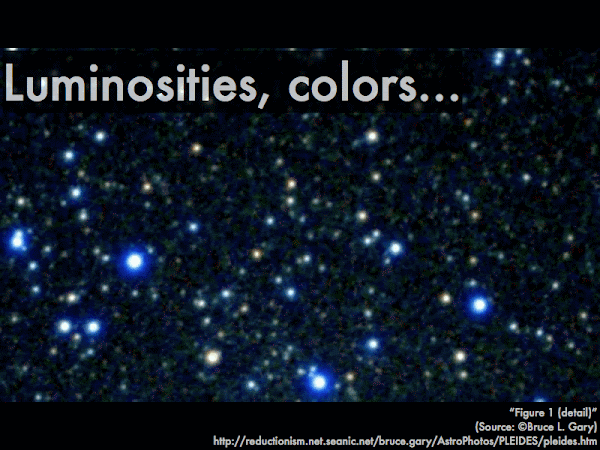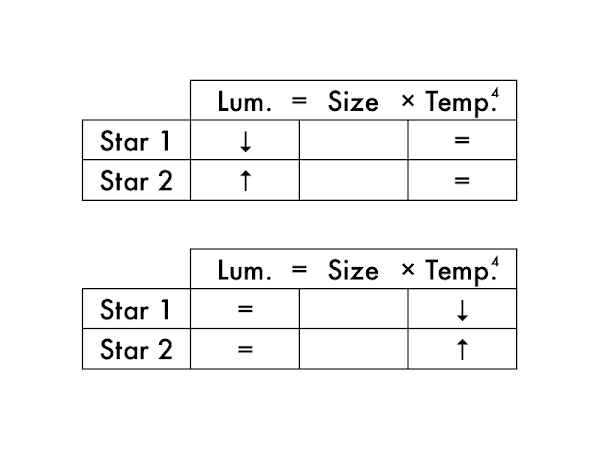Cuesta College, San Luis Obispo, CA
Students have a weekly online reading assignment (hosted by SurveyMonkey.com), where they answer questions based on reading their textbook, material covered in previous lectures, opinion questions, and/or asking (anonymous) questions or making (anonymous) comments. Full credit is given for completing the online reading assignment before next week's lecture, regardless if whether their answers are correct/incorrect. Selected results/questions/comments are addressed by the instructor at the start of the following lecture.
The following questions were asked on reading textbook chapters and previewing presentations on parallax, distance, apparent magnitude, absolute magnitude, Wien's law and the Stefan-Boltzmann law, and a TED-Ed talk on stellar properties.

Selected/edited responses are given below.
Describe something you found interesting from the assigned textbook reading or presentation preview, and explain why this was personally interesting for you.
"How the color and size of a star is related to its temperature and luminosity."
"How stars have different temperatures and that from their color alone tells you if they are cool or hot."
"I found it interesting how stars' brightness is measured, because I honestly never even considered it before."
"The way that they categorize the brightness of a star: the more lower the number or negative I guess you would say, the brighter it is. This is interesting to me because we are always taught that negative numbers are lower than one so a person would assume that because of the negative number it would be less bright. Such is not the case though which makes me wonder why when they revised it they did not revise that section of it?"
"That a negative magnitude means a brighter star; I thought that the highest would of been the brighter."
"How to actually determine the distance between bodies in space using parallax."
"I never thought that there was a reason on why stars looked brighter than others."
Describe something you found confusing from the assigned textbook reading or presentation preview, and explain why this was personally confusing for you.
"I thought it was confusing how scientists are able to get the size and temperature of stars to figure out the absolute magnitude because they don't have any tools that could get close enough to measure."
"I am still puzzled on how we can tell the size of star by its color and brightness. How is it that we know the temperatures of these stars in accordance to the color? Have we had the technology to be able to gauge these stars without being that close to them? I guess I will just need a little more light on the subject."
"Pretty much the whole textbook reading confused me. not to sure how to figure out temperatures and brightness."
"Why is red considered the coolest star color, because when we think about 'red' we usually think 'hot.'"
Explain how apparent magnitude and the absolute magnitude are defined differently.
"Apparent magnitude is how bright a star appears from Earth, and absolute magnitude is how bright the star appears from a standard distance."
"Apparent magnitude is how bright a star appears from our location, and the absolute magnitude is when they are from the same distance."
"Apparent magnitude is the 'as is' brightness of a star, whereas absolute magnitude is the 'actual' brightness."
"Apparent magnitude refers to the brightness of a star as seen by an observer on Earth, without any compensation of instruments to change the view; it is what appears to the naked eye. Absolute magnitude is a whole lot more specific and clear; it calculates the ACTUAL brightness of a star, not just going by what we see. It is determined when a star's brightness is placed 10 parsecs away from all other stars."
Suppose the sun was moved to a distance of 10 parsecs away. As a result, its __________ magnitude would become dimmer.
absolute. ****** [6] apparent. ******** [8] (Both of the above choices.) [0] (Neither of the above choices.) [0] (Unsure/guessing/lost/help!) [0]

(Only correct responses shown.)
1 (brightest): the sun, m = –27 [100%]
2: Canopus, m = –1 [86%]
3: Vega, m = 0 [86%]
4 (dimmest): Kapteyn's star, m = +9 [93%]
Rank the brightnesses of these stars (1 = brightest, 4 = dimmest; there are no ties), if relocated to 10 parsecs from Earth.
(Only correct responses shown.)
1 (brightest): Canopus, M = –3 [57%]
2: Vega, M = +0.5 [79%]
3: the sun, M = +5 [57%]
4 (dimmest): Kapteyn's star, M = +11 [86%]
Determine whether these stars get dimmer or brighter when relocated from their original positions to 10 parsecs from Earth.
(Only correct responses shown.)
The sun: gets dimmer [64%]
Canopus: gets brighter [71%]
Vega: gets dimmer [50%]
Kapteyn's star: gets dimmer [79%]
Rank the temperatures of these main sequence stars (1 = hottest, 4 = coolest; there are no ties).
(Only correct responses shown.)
Hottest: blue main sequence star [86%]
Second hottest: white main sequence star [71%]
Third hottest: yellow main sequence star [86%]
Coolest: red main sequence star [93%]
Rank the temperatures of these supergiant and dwarf stars (1 = hottest, 4 = coolest; there are no ties).
(Only correct responses shown.)
Hottest: blue supergiant [79%]
Second hottest: white dwarf [14%]
Third hottest: yellow supergiant [43%]
Coolest: red dwarf [86%]

dimmer. *** [3] brighter. ********** [10] (These stars would be the same size.) * [1] (Unsure/guessing/lost/help!) [0]
Two stars (equally far away) have the same brightness, but one star is cooler, and the other star is hotter. The __________ star will be larger in size.
cooler. *** [3] hotter. ******** [8] (These stars would be the same size.) ** [2] (Unsure/guessing/lost/help!) * [1]
Ask the instructor an anonymous question, or make a comment. Selected questions/comments may be discussed in class.
"With a blue star being the hottest, have we found any with planets around it that are in that 'Goldilocks zone?'" (Not yet. Although even if we did discover a territorial exoplanet orbiting a massive blue main-sequence star, it would not have very much time for life to arise before the star explodes as a type II supernova, as massive stars have very short lifetimes.)
"How can we tell the different colors when looking at the stars from Earth?"
"This was very confusing!"
"I enjoyed this section. I thought it was interesting and I felt like I understood it."
"This class is fun but hard :))))))"
No comments:
Post a Comment